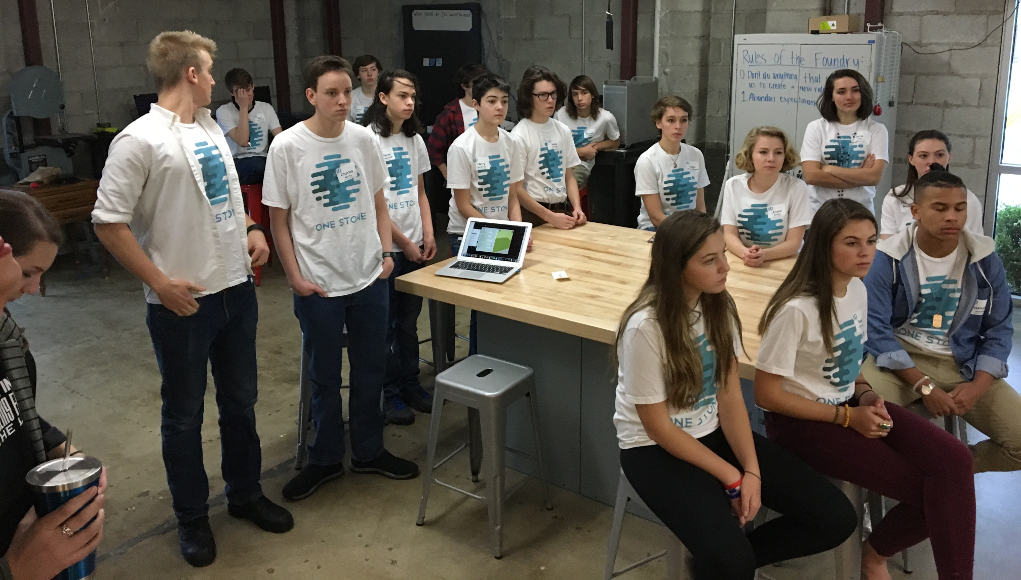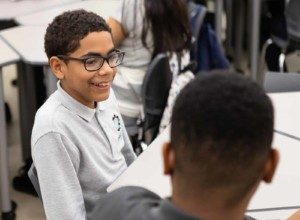Designed for Learning: At School and At Home

This blog originally published on Love2LearnIdaho
“My favorite parts of One Stone is the accountability you have for your own learning. When I’m working on a project I have to have to work on that project myself and if that project doesn’t work out I don’t get a C, I continue working on that project until it works. There’s not sitting back and giving up. You have to finish the project, you have ownership of the project.”

Jared wasn’t exactly a stellar student last year. This year he is a budding coder and takes responsibility for his own learning. The difference is a place designed for learning.
Jared is a student at One Stone, a new project-based high school in Boise where students take on real challenges.
The Foundry is a makerspace at One Stone where Jared learned how to make things using a laser cutter and 3D printer. Jared built a computer network (using a Raspberry Pi kit) and learned to program in several languages.
One Stone is a new small school that teaches students to attack problems using a design thinking process. The iterative design process teaches students that it may take more than 50 attempts (hence the One Stone phrase, “51 it”) to solve a problem. The process starts with a deep investigation that teaches students to define and understand a problem and empathize with another group of people.

The design thinking process has been honed for eight years in three afterschool programs focused on design, community service and entrepreneurship.
The new One Stone high school is designed for learning. It doesn’t have a lot of trappings of a traditional high school–there’s no prom or football team–but the school does build on the success of three after-school programs that have demonstrated the power of ownership, empowerment, and trust.
Everything at One Stone–the facility, technology, culture, design process, projects, and partnerships–is designed for learning. Students have voice and choice in the learning–they even sit on the One Stone board of directors.

One Stone coach Woody Sobey (below) helped Jared and other One Stone students create the Foundry (and code the flashing F in the Foundry sign).

In January, One Stone coaches like Woody guided student discussions about Designing Your Life, a popular book by two Stanford professors that applies the design thinking process to career planning.
After learning to use the Adobe creative suite, One Stone students began making a mind map of their strengths and interests to begin to identify their opportunity to make a contribution.
Students are writing across the project-based curriculum. They review each other’s work and receive critical feedback from coaches. This month they will publish personal biographies on their own WordPress site.
8 Things To Look For At School
One Stone is a remarkable new school that illustrates important design principles of schools that provide high-quality preparation for careers and citizenship. At a recent ED Sessions event at One Stone, students led discussions with Boise community members about the attributes of schools that promote powerful learning. Eight of the characteristics mentioned included:
- Big ideas (common mission, a focus or theme, and shared teaching strategies) that make everything work together for students and teachers
- Big blocks of time and flexible spaces for taking on big challenges
- Engaging and relevant learning
- Powerful sustained relationships
- Equitable access to technology
- Evidence that learners show what they know in exhibitions of learning
- Community connections and partnerships
- Lots of professional learning opportunities for teachers
Anthony Warn from Bluum, a Boise school support organization said it all starts with leadership that expects school to be more.
4 Ways To Promote Powerful Learning At Home
There may not be a school in your neighborhood that has all of the One Stone characteristics, but there is a lot you can do to promote powerful learning. A two-year investigation into smart parenting identified four traits that have a lot in common with One Stone. Smart parents are:
- Involved. Smart Parents are involved in their children’s lives. They promote student-centered learning exploring options for how, where and when their children learn. They encourage college and career preparation by ensuring that they are progressing at a pace that is right for them, not bored or overwhelmed. They learn alongside their child and involve them in the world of adult work.
- Informed. Smart Parents are informed about their children as learners. They are advocates for their learning. They use trips and technologies to activate learner interests. They share information with teachers, mentors, and other providers involved in the son/daughter’s learning. They do the research and look for schools that support student-centered and competency-based learning.
- Intentional. Smart Parents are intentional about creating powerful learning experiences. They cultivate mindsets and habits that support lifelong learning. They share intellectual curiosities and model the struggles and joy of learning. They spot opportunities to learn and demonstrate learning in the community through internships and service projects. They promote ownership and involve learners in determining when they feel ready to try something new or on their own. They eat dinner together and talk about the world.
- Inspired. Smart Parents are inspirational as learning guides and role models. They find ways to encourage learners to try, to persist, to present, and to progress. They watch, listen, empathize, connect and activate.
Like coaches at One Stone, smart parents appreciate that every young person is unique and that their role–the mixture of expectations and supports – is uniquely adjusted for each learner.
What is common is a commitment to cultivating unique talents and linking them to a cause they care about. Smart parents help young people discover and explore their passion and purpose.
For more, see:
- One Stone Launching Innovative New High School in Boise
- Smart Parents: Parenting for Powerful Learning
- Smart Parents are Involved, Informed, Intentional, and Inspirational
Stay in-the-know with all things EdTech and innovations in learning by signing up to receive the weekly Smart Update. This post includes mentions of a Getting Smart partner. For a full list of partners, affiliate organizations and all other disclosures please see our Partner page.







0 Comments
Leave a Comment
Your email address will not be published. All fields are required.